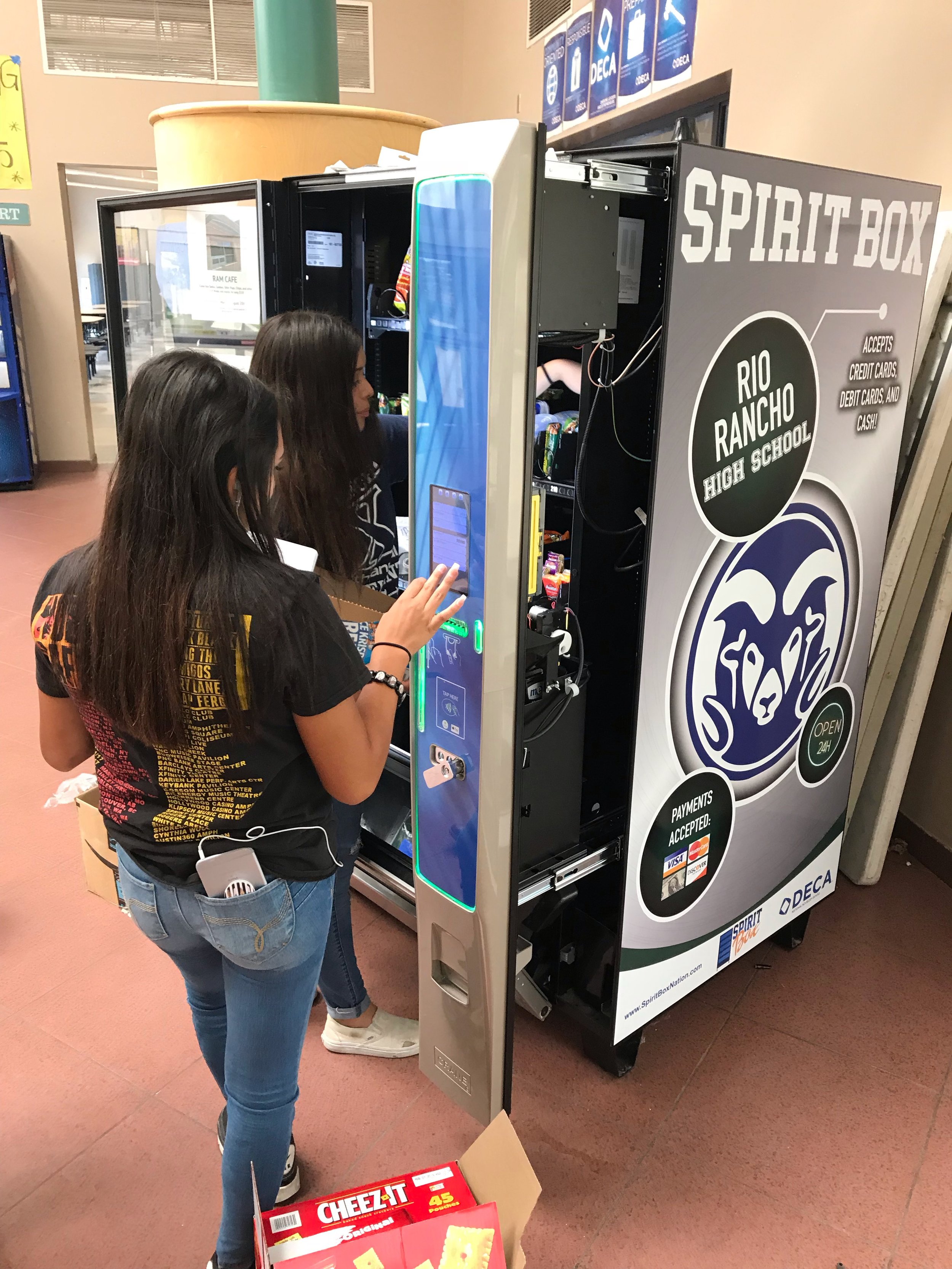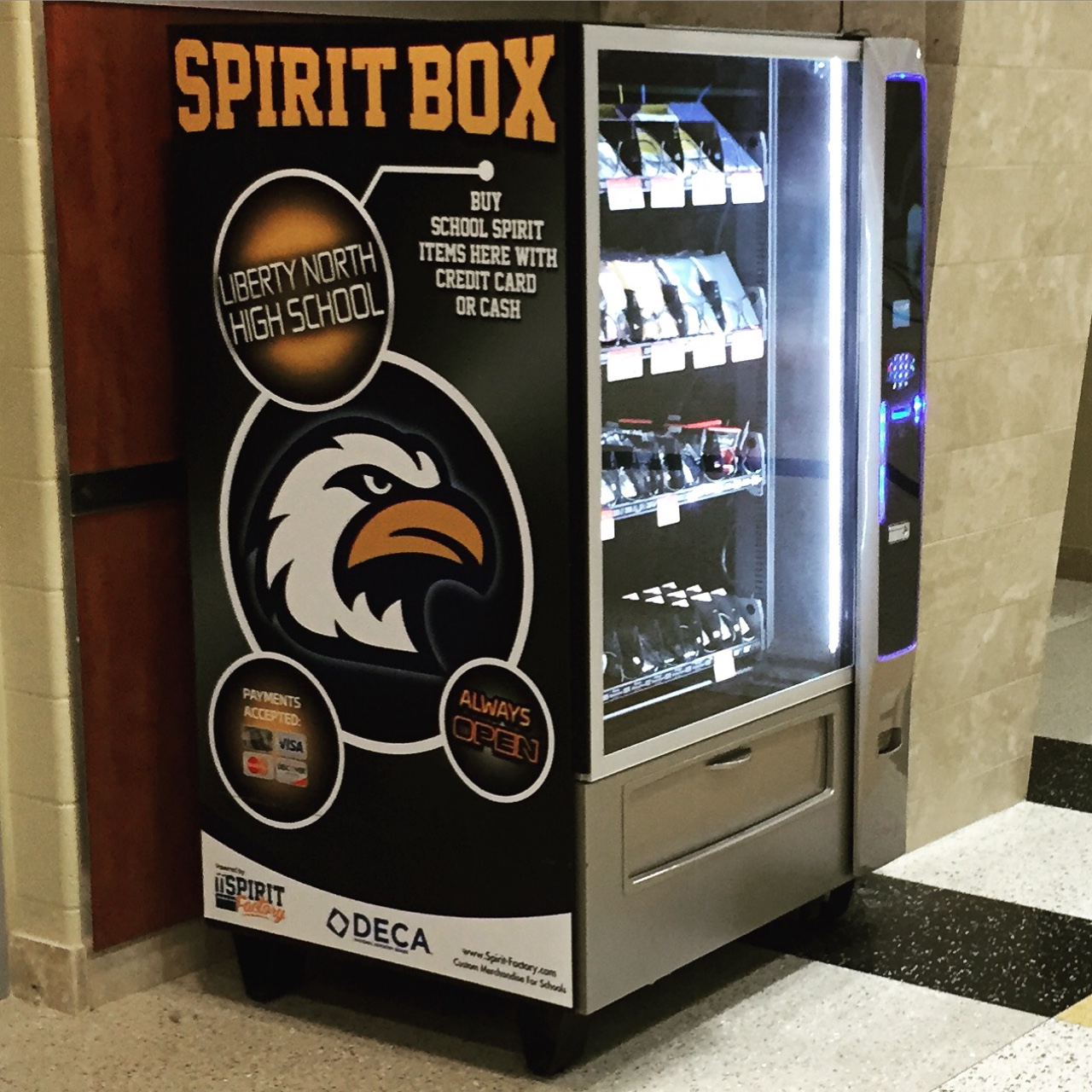10 Ways to Fund Your School Store Vending Machine
Funding Your New Enterprise Start-Up
Unless you are simply selling your time, every new business will have some form of start-up investment to launch and cash flow the start-up until it’s self-sustaining. This step can be daunting and becomes an idea-killing obstacle for many “would-be” businesses.
Our mission with Spirit Box is to provide a hands-on learning experience for students where they can gain skills and confidence in business and entrepreneurship with little to no risk. For many of our current Spirit Box teams that learning experience was tested right out of the gate when they had to figure out how to pay for their initial Spirit Box investment.
This guide was developed to help you with that first start-up obstacle by providing ideas, sources, and methods to get the investment you need to launch. The primary source of these ideas is based on what other schools have done before you. Our hope is this will open up your thinking into many more ways to navigate this obstacle!
How much should I try to source?
Plan ahead and be conservative. If you had a blank check we’d recommend raising funds for the box purchase PLUS any initial cash you will need to be self-sustaining. For example, be sure to add in:
any initial product stock beyond the supplied initial starter pack
your first batch of $1 coins needed for change
office and promotional supplies
funds for initial promotions (grand opening, posters, etc.)
Let’s get started with finding your funding!
Grants and Donations
Grants or some other kind of funding that doesn’t have to be repaid will position your Spirit Box to generate profits almost immediately. Without any kind of debt service for your new business venture all of your profit can immediately go back into new products, trip fundraising, etc.
#1 -- Start in your school
The first stop on your quest should be in your own hallways. Talk to your school’s administers first. They need to be on board with your project, but sometimes have discretionary budgets available for larger initiatives (albeit rare). If they don’t, they’ll know who at the district level you should talk to next for potential funds. (See #2 -- District-Level Funding)
#2 -- District-Level Funding
From our experience many districts have a Career Technical Education (CTE) Coordinator or similar role that administers, monitors and implements the requirements for a quality CTE program and all grant requirements. This centralized resource is likely your main contact to find and apply for potential funding through state or district-level programs.
#3 -- Carl D. Perkins Grant Funds
One specific source of successful grant funding some of our Spirit Box schools have received has been via the Carl D. Perkins Career and Technical Education Grant. This is a $1.2B grant fund that is awarded from the U.S. Government to states and then allocated to various districts and schools based on state-designed factors.
Specifically, the purpose of the Carl D. Perkins Career and Technical Education Act of 2006 (Perkins IV) is “…to develop more fully the academic, and career and technical skills of secondary education students and postsecondary education students who elect to enroll in career and technical education programs, by:
Building on the efforts of States and localities to develop challenging academic and technical standards and to assist students in meeting such standards, including preparation for high skill, high wage, or high demand occupations in current or emerging professions;
Promoting the development of services and activities that integrate rigorous and challenging academic and career and technical instruction, and that link secondary education and postsecondary education for participating career and technical education students;
Increasing State and local flexibility in providing services and activities designed to develop, implement, and improve career and technical education;
Conducting and disseminating national research and disseminating information on best practices that improve career and technical education programs, services, and activities;
Providing technical assistance that:
Promotes leadership, initial preparation, and professional development at the State and local levels; and
Improves the quality of career and technical education teachers, faculty, administrators, and counselors;
Supporting partnerships among secondary schools, postsecondary institutions, baccalaureate degree granting institutions, area career and technical education schools, local workforce investment boards, business and industry, and intermediaries; and
Providing individuals with opportunities throughout their lifetimes to develop, in conjunction with other education and training programs, the knowledge and skills needed to prepare individuals for high demand, high skill, or high wage occupations.
Most states accept grant submissions in the Spring with awards coming in the Summer. If you do not have a CTE Coordinator or the equivalent, then we’d recommend contacting your state’s Perkins point of contact directly as each state has a different process and set of requirements for funding allocation.
#4 -- Title I Schools Grant Funds
Title 1 Schools are our oldest and largest federally funded education program, according to the U.S. Department of Education. It dates from 1965 and its main purpose has been to help underprivileged children meet challenging state academic standards. In other words, schools with a student base that are lower-income are provided with Title 1 funding in order to help those who are behind or at risk of falling behind, aiming to bridge the gap between low-income students and other students.
Depending on your individual school’s needs, these grant funds may be harder to come by, but not unheard of. Title 1 programs provide services that enhance and support the regular classroom program -- for this project, we’d recommend you focus your request on “specialized instructional methods and purchase of teaching equipment and supplies”.
If you are a Title 1 school check with your school’s administration for budget availability or process to participate in subsequent school years.
#5 -- So Many Other Grants
Beyond federal assistance there are grants sponsored by states, local municipalities, as well as for-profit and nonprofit organizations. Start local and then branch out. Finding other grants will take some searching and detective work, but there are many opportunities. Here are some nationwide opportunities as well as a few aggregator sites to get you started:
Donors and Corporate Sponsorship
Who better to champion your efforts to launch a real-life, student-based enterprise that teaches business and entrepreneurship than local entrepreneurs and business people? They are passionate about your community and want to see healthy, economic growth and development. Spirit Box is a program that the local business community will be excited to support.
Start Networking
So, while your grant requests are simmering, it’s time for your prospective Spirit Box team to pound the pavement and shake some hands. We suggest you start by attending local events and meetings where you can begin to pitch your ideas to many people in one setting. For example:
Chamber of Commerce and Rotary Club meetups
Other local entrepreneur-centric meetups like 1MillionCups
Networking meetups like a BNI Chapter or a Mastermind Group
Your local leaders are getting together somewhere. Find out and join them. Even better, see if you can do a 5-minute presentation to the group on your new startup. If meetups are sparse or non-existent in your area start meeting with business owners and leaders one-on-one. Start with the ones that are most visible and always ask for referrals. If they can’t sponsor you financially, they definitely will introduce you to other potential sponsors.
#6 -- Donor or Sponsorship Package
Before you begin your networking tour, brainstorm what it is you are asking for and are offering in return. While goodwill donations are feasible, you will get much more buy-in if the company feels they are getting something tangible in return for their sponsorship. What can you offer? Here are a few ideas to get you thinking:
Your Spirit Box graphics wrap is made custom for your school, so we could easily incorporate one or more logos from sponsors. (e.g., “This Spirit Box is sponsored by these great local businesses”)
If their business sells to or employs your school’s demographic, offer them free advertising spots on rotating slideshow on a TV on top of your Spirit Box. For a $200 investment in a TV you can not only promote the Spirit Box, but you can offer sponsors and advertisers access to a very targeted audience with thousands of views a week if your box is in a high-traffic area.
You could have one sponsor or many. Give them options so they can sponsor at a level that fits their budget. This source of funding could single-handedly get you the funds you need to launch your Spirit Box.
It’s more than just money
There is a wealth of real-world knowledge just blocks from your school. Don’t just ask for their financial investment, ask them to partner with you on a deeper level by engaging with your class on a regular basis to teach you more about how business works and help you work through questions and ideas your team might have.
Other Bootstrapping Options
To avoid debt, here are some additional options some schools have found successful in offsetting cost:
#7 -- 3rd Party Fundraising Platforms
Using sites like donorschoose.org, gofundme.org and adoptaclassroom.org are fairly easy to implement and share with your school community digitally.
#8 -- Good, Old-Fashioned Fundraising
Garage sales, car washes, bake sales, selling candy bars, etc. are fundraising options most schools are comfortable organizing and students have experience selling.
#9 -- Add a Program Fee
While this would need to be approved by your administration, your school could charge each student a small subsidy to help pay for equipment, technology, etc.
#10 Borrow
Your goal is to fully fund your Spirit Box, but you still have a gap. Sweeten donations with promises to partial or fully repay the school, investors or donors, or simply apply for a small biz loan.
Two final notes on funding your Spirit Box
Use multiple sources -- it all adds up, so don’t be afraid to ask for less from your sources and stack them up with others.
Don’t quit -- this is the real world. Most prospective business owners need to raise capital one way or another. Consider this Lesson #1 on your Spirit Box hands-on journey. Bonus is that if the team does the work to raise the money themselves, they are WAY more likely to want it to succeed. They will be emotionally invested at that point.
Use us! We honestly believe that lack of funding for your Spirit Box startup can be overcome 100% of the time. We aren’t saying it will be easy and quick, but we know it can be done.
____
Be sure to check back or follow us on Twitter, Instagram or Facebook for more stories like these.



